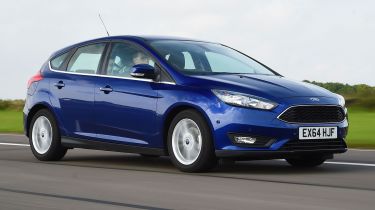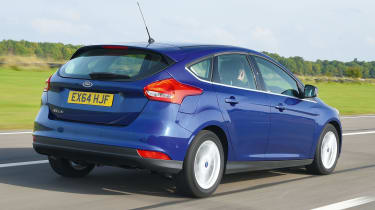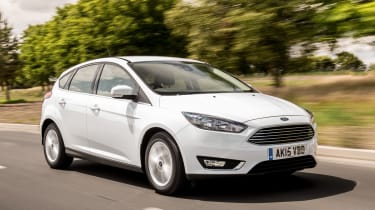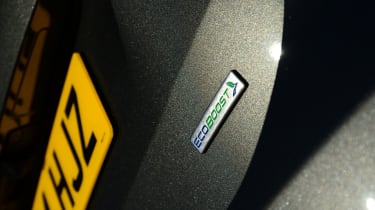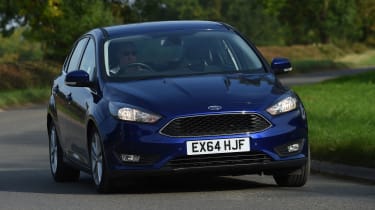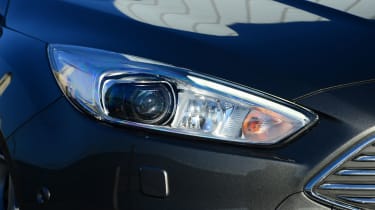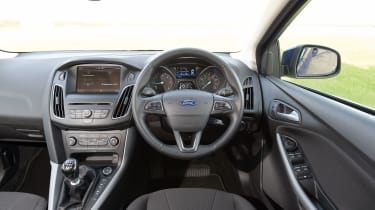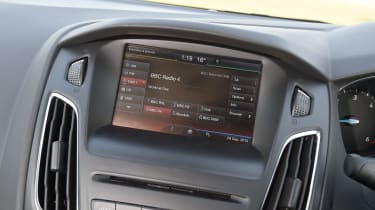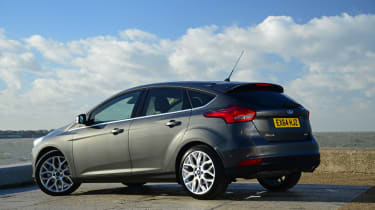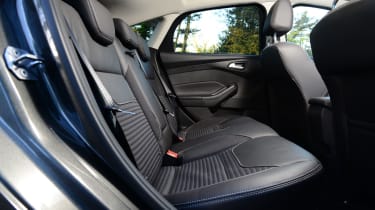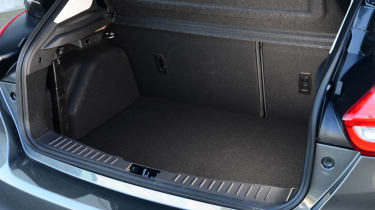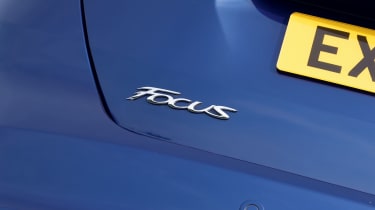Ford Focus (2011-2018) review
The Ford Focus is due for replacement soon, but remains an impressively strong contender

The Ford Focus is one of the best known names in the car world, which is hardly surprising after nearly twenty years at the top of the C-segment sales charts.
The Focus for sale now is the third generation, launched in 2011 and significantly upgraded in 2014 as part of a mid-life facelift. As that chronology suggests, there’s a fourth generation Focus arriving next year – indeed it’s no secret, as Ford has been testing prototypes in public with the hashtag #TimeToFocus.
• New 2018 Ford Focus spied testing
The 2018 model is evolutionary rather than revolutionary, but given the enduring strengths of the current car that could be no bad thing. Even this late in its career the Mk3 Focus remains a strong alternative to a formidable range of high quality rivals including the VW Golf and Vauxhall Astra, SEAT Leon, Audi A3, Honda Civic, Peugeot 308, Renault Megane and Skoda Octavia.
The Focus has retained its top slot thanks to that 2014 update, when Ford revamped the engine line-up and added an array of the latest tech. The facelift also sharpened up the style, and brought the model into line with newer designs like the Ford Mondeo, including on the inside as the cabin was thoroughly updated.
Used - available now

2023 Ford
Focus
13,097 milesManualPetrol1.0L
Cash £17,200
2020 Ford
Focus
33,551 milesManualPetrol1.0L
Cash £10,677
2020 Ford
Focus
50,813 milesManualPetrol1.0L
Cash £10,995
2023 Ford
Focus
19,797 milesManualPetrol1.0L
Cash £16,200The Focus is available in two bodystyles, the standard five-door hatchback and even more practical Focus Estate.
The Focus price list kicks off with the Focus Style ECOnetic which is an economy special offering up to 82mpg from its 1.5TDCi turbodiesel, or the similarly priced Focus Zetec Edition with 1.0T Ecoboost 99bhp engine. You can specify higher power versions of both engines in the Zetec Edition too, and it’s a popular spec with Ford SYNC 3 and satnav on an 8-inch touchscreen, cruise control, 16-inch alloy wheels and power windows and mirrors all featuring.
Moving up to the Focus Titanium adds auto headlamps, LED running lights, rain sensing wipers, City Stop, along with dual zone climate control. You can also select 1.5-litre petrol and 2.0-litre diesel engine options. The luxurious Titanium X gives you big 17-inch alloys, Bi-Xenon headlamps, Active Park Assist, a rear-view camera and partial leather trim.
Sporty Ford fans will prefer the Focus ST, which comes in three versions and provides a genuine alternative to the VW Golf GTi. The real show-stopper in the fast Focus range though, is the 345bhp Focus RS with its four-wheel drive chassis and spectacular bodykit.
The popular C-Segment Ford is also available with electric power. The Ford Focus Electric is rare because practicality is compromised compared to the standard hatch, and then there’s the limited range. Ford claims the Nissan Leaf and BMW i3 as rivals, but both of these are less compromised.
The Ford Focus has been a best-seller in the UK for many years, and the latest generation is even better. Unveiled in 2011, it was heavily updated in 2014, bringing some new engines, a new front grille, and a higher-quality interior.
The Focus isn't perfect - while the latest car is more refined and better built than those that have gone before, it's lost some of the handling sparkle that defined the original as one of the best cars in its class. It still offers offers a great blend of ride and handling, though, and amongst most rivals it's great to drive.
Up front it's genuinely comfortable, but taller rear passengers might find things a little cramped. The boot's small, too, and is now beaten by many models in the class below.
The engines are great though, with a wide range of petrols and diesels on offer. There's also a slow-selling Focus Electric, though it can't compete with more modern rivals when it comes to range. The three-cylinder EcoBoost petrol units are especially strong, and remain our pick of the range.
Engines, performance and drive
The Focus has clearly been designed with comfort and efficiency in mind, but Ford's talented engineers haven't neglected handling. It's certainly a more exciting steer than a Kia Cee'd and it offers up more agile handling than a Volkswagen Golf. Turn-in is sharp, while the great chassis serves up strong grip. In many ways it’s like a big Fiesta, and there's no higher compliment for a front-wheel drive car than that.
The Focus is settled at motorway speeds, with the suspension doing a good job of soaking up bumps. The car is very surface-sensitive though – rougher motorways produce a lot more road noise in the car than newly resurfaced ones, whereas rivals mask surface changes better, especially more comfort-oriented ones like the Citroen C4.
But it’s on twisty roads that the Focus really excels. Its ability to communicate accurately what’s going on between the tyres and the road sets it apart from the average family hatchback. Rivals like the Mazda 3 and SEAT Leon have caught up, however, representing a high dynamic benchmark.
It’s a trick of balance that Ford has become a master at pulling off, and it makes the Focus one of the best all-rounders in any segment of the car market. And because they’re so similar in feel, that applies to the Estate as well.
That said, today’s Ford Focus is not quite as focused as past models, although it’s worth noting that the facelifted versions (2014 onwards) had their suspension and steering tweaked in response to criticism to that effect.
Those wanting a sportier version of the Ford Focus can choose the ST, one of the best hot hatchbacks available on the UK market. Its powerful engine helps the car reach 0-62mph in just 6.5 seconds, and although the ride quality is generally firmer – more prone to bounce on rougher surfaces – it’s still comfortable.
The new ST-Line model replaces the old Zetec S, and adds all the style of the full-fat ST, but with a range of economical engines. Lowered suspension means it is on the firm side, though.
The RS, meanwhile, is a serious piece of high performance kit – it’s still a family hatchback, of course, but that characteristic is a distant second to the business of going quickly. It breaks the 62mph barrier in well under five seconds and comes with a very sophisticated suspension setup in order to stop that 345bhp engine from overwhelming the front wheels.
A Mountune version ups this to a frankly astonishing 370bhp, without affecting the manufacturer warranty. If that’s not enough tweaking of the impressive Focus RS formula, Ford is also offering an option pack now, which mostly consists of visual tweaks, plus a Quaiffe limited-slip differential, designed to deliver even more traction when exiting a corner. Both are great to drive, and both were awarded five stars when we drove them in the UK.
Regardless of specification the Focus has one of the most pleasant manual gearboxes in the business, with a lovely light action and accuracy through the gate – both the five-speed gearbox of lower powered petrol engines and the six-speeder of the diesels have this characteristic.
Ford’s automatic transmission option in the Focus is called Powershift and is a twin-clutch type, the same as Volkswagen’s DSG. It’s not quite as smooth or quick to change gear as the VW unit, but it’s still a sophisticated, non-obtrusive gearbox that doesn’t degrade the Focus’s fundamentally excellent driving experience.
Engines
The pre-facelift version of the Focus (2010–2014) came with a 1.6-litre TDCi diesel engine, but Ford replaced this for a 1.5-litre unit with the facelift, available with 94bhp or 118bhp outputs.
Don’t be fooled by the capacity decrease – the slightly smaller engine is better. Smoother and more efficient than the outgoing 1.6-litre engine, what both versions lack in outright power, they make up for with punchy low-end torque (250Nm at 1,500rpm and 270Nm at 1,750rpm respectively) so they feel strong.
There’s a 2.0-litre TDCi diesel unit too, in two states of tune. The lower powered boasts 148bhp and, more importantly, 370Nm torque from just 2,000rpm. That trumps the figure of the 148bhp 2.0-litre TDI Volkswagen Golf by a full 50Nm and gives a so-equipped Focus a 0-62mph time of 8.8 seconds (9.0 in the Estate).
The more powerful 2.0 TDCi has 182bhp and is only available in the ST diesel model, introduced with the 2014 facelift. It has a brutal 400Nm torque (10Nm more than a Porsche 911 Carrera), and so feels a whole lot quicker than its 8.1-second 0-62mph time.
Both of these bigger diesels offer true low rev flexibility, meaning the lazier driver can comfortably pull away from low speed roundabouts in third gear, although as per most four-cylinder diesel engines it’s not the last word in quiet smoothness, especially before it’s warmed through.
The Focus has always had a reputation for serving up more driver thrills than the average hatchback, and the 1.0-litre EcoBoost engine, especially in 123bhp guise, suits its sporty nature. So too does the new 1.5-litre EcoBoost engine, available with either 148bhp or 180bhp.
Although the three-cylinder thrum from this 1.0-litre model won’t be to all tastes, the six-speed manual version features a dual-mass flywheel that eliminates vibrations well, and it’s certainly a change from a typically bland four-cylinder engine note. We'd avoid the Powershift auto paired with this engine, though, as it make it feel lethargic and hesitant in its power delivery.
• Ford Focus vs Vauxhall Astra vs SEAT Leon
The lower powered 99bhp EcoBoost engine is very popular with buyers and available with all trim levels bar sportier-looking ST-Line. On paper it doesn’t look much cop (0-62mph takes 12.5 seconds with a 115mph top speed), but in reality it's torquier and punchier than the four-cylinder petrol engines in the Focus range. It's therefore more flexible at lower speeds.
Those four-cylinder petrol engines are the weakest of the Focus bunch, and really only worthy of consideration if you’re looking to keep your buying costs down. Available with 84bhp or 103bhp, they need to be worked hard to make the most of their performance, and their tone lacks the character of the three-cylinder engines. They’re not as smooth either.
By contrast, the Focus’s pair of high performance turbo petrol engines, namely the 247bhp 2.0-litre four-cylinder turbo in the ST and the 2.3-litre unit with 345bhp in the RS, are among the hot hatch greats. If that's not enough, you can add a Mountune package for £899 – upping power to 370bhp.
MPG, CO2 and Running Costs
If you don't count the sporty Ford Focus ST and RS models, every car in the line-up emits less than 140g/km of CO2, which is pretty good if you consider how large and wide-ranging the engine line-up is.
Despite the car having more safety kit and generally being more refined, Ford has managed to make the new Focus lighter than the two previous versions. As a result it’s cheaper to run generally, but the lower-powered EcoBoost petrol engines and TDCi diesel stand out.
For example, the 99bhp version of the 1.0-litre three-cylinder turbo petrol returns 105g/km CO2 in standard form, though strangely, for a little extra on the list price (£350), Ford will sell you a 99g/km version. That’ll save you £20 per year in VED from the second year onwards, while the mpg difference between the two is 65.7mpg versus 61.4mpg.
In most cases the Estate version of the Focus is a few mpg less economical than the five-door hatchback (there’s no three-door option for this generation), owing to the extra weight and slightly less slippery shape.
While the Focus Electric is the most economical version on paper, with zero tailpipe emissions, it’s really a non-starter in reality if you’re looking at minimising your costs. What you’ll save in fuel, a zero VED bill or tax incentives (if you’re a company car driver), you’ll pay out on the car itself – it costs £31,000 before the £5,000 electric car grant is applied. It’s also compromised on space and drivability.
The 118bhp 1.5-litre TDCi diesel is also a sub-100g/km car offering zero VED and generally very low costs, owing to 74.3mpg combined cycle economy – and even the most powerful diesel, the 182bhp version in the ST, emits just 110g/km CO2 and returns 74.3mpg.
The last generation Focus had a pricing structure that looked high, allowing dealers to slash the prices and entice buyers with ostensibly large discounts. Ford was rightly criticised for that, so this time around the pricing is more realistic – and great value.
The entry-level Focus, at under £16,000, undercuts an entry-level Golf by a good £1,500 – especially impressive considering it’s well equipped, with Ford having dropped the spartan Studio model in 2014. Generally speaking, the list prices compare favourably with mainstream rivals like the Vauxhall Astra, Peugeot 308 and SEAT Leon.
The Zetec S models are where things start really looking sporty, but the lower powered of those (the 123bhp EcoBoost petrol and 118bhp TDCi diesel) won’t break the bank. The former returns 60.1mpg combined (our favourite all-round engine), and the latter an even better 74.3mpg.
• Ford Focus vs Nissan Pulsar vs SEAT Leon
The 1.5-litre Ecoboost with 148bhp fares notably worse, however, returning 51.4mpg and 127g/km CO2, while the ST hot hatch can only manage 41.5mpg combined and 159g/km CO2 – worthy of a £180 annual charge.
It’s fair to say that costs won’t be such a big deal for RS buyers, and it’s a good job too: 36.7mpg and 175g/km aren’t too bad given the performance, but you’ll be looking at mid-20s economy in reality.
It’s also worth noting that the Powershift automatic, despite being of the twin-clutch type that’s supposed to have minimal effect on economy, quite substantially reduces mpg ratings. The 70.6mpg 2.0-litre diesel returns 70.6mpg with a manual gearbox, for example, but 64.2mpg with Powershift.
Insurance Groups
The Ford Focus’s insurance ratings start at group 11 for entry-level cars, while the RS has insurance costs more akin to the premium Audi RS 3, a group 40 model.
Our favourite all rounder, the 123bhp 1.0-litre Ecoboost, which in most trims (including the sportier ST-Line) is in insurance group 14 as both a hatch and estate. It’s not just because the car is safe, reliable and secure, but because Ford’s dealer network is expansive (over 750 in the UK) and the parts supply abundant – so in the event of an accident, the repair costs are very reasonable. In addition, mid-level Ford Focus hatchbacks are not, frankly, the most alluring to potential thieves. ST and RS models aside, that is.
Depreciation
Due to the popularity of the Ford Focus, you're likely to find plenty for sale on the used car market, while parts and servicing are relatively inexpensive. However, residuals aren't as good as the Volkswagen Golf and you'd probably be lucky to get even 40 per cent of its value back after three years and with average mileage. The Volkswagen Golf and SEAT Leon trump the Focus for residuals, though it is better than the Vauxhall Astra, which has residuals that are notoriously poor.
But again, that general rule doesn’t apply to ST and RS models, which are both rarer and more desirable and therefore enjoy better residuals. An ST-2 or ST-3 specification version of the former will always be easier to sell on than the more basic entry-level ST.
Interior, design and technology
The facelift in 2014 smoothed out a lot of the Focus’s visual awkwardness, making it a lot more stylish in the process. Where it was slightly anonymous, even a little ugly, the post-2014 car looks classier with its new narrow headlights and chrome grille.
The biggest changes in 2014 were reserved for the cabin, where the all-new dashboard is more minimalistic and classier than before – addressing criticism of the second generation car (and the first version of the third generation) about its fussy, button-heavy design. It was baffling to use, thanks to myriad odd-shaped buttons, especially for the standard stereo head unit.
That’s changed, but the Focus still doesn’t have the class or intuitive sophistication of a Volkswagen Golf or SEAT Leon – in fact, Ford could really learn a thing or two about tasteful cabin design from the Volkswagen Group products in general.
But let’s not be too harsh – material quality is good, with soft-touch plastics and improved climate-control switches that are larger and clearer than they were. The blue-lit instruments look classy, while a larger trip computer display between the dials is easier to read.
A small central colour display screen is standard. It’s on the small side really, and not too clear, but the controls are easy to operate. Still, it’s much better to pay extra for the Ford SYNC navigation system (a reasonable £250 option on Zetec cars, or £500 with Style) that makes the screen larger and adds DAB radio.
Bluetooth is standard on all models, as is air conditioning, but you’ll have to upgrade to a Zetec for alloy wheels, heated door mirrors and nicer interior trim. Titanium trim is where things start to look positively luxurious though, with dual-zone climate control, parking sensors, adaptive cruise control and velour seats.
ST-Line and Titanium X models are top-of-the-range (before you come to the proper ST and RS versions, that is), with the former focusing on sportier options like bigger wheels and a bodykit, and the latter more on luxury kit like xenon headlamps, heated electric seats and leather upholstery.
The Focus also features Ford’s MyKey technology, which allows the main driver to restrict another user (or users) of the car. It’s designed for parents to rein-in their new driver offspring, basically; MyKey will disable the stereo completely until the seatbelts are fastened, warn about a low fuel level much earlier, and prevent the traction control system from being disabled, for example.
Sat-nav, stereo and infotainment
The Focus doesn’t have the best track record in terms of the intuitiveness of its stereos, especially from the second generation Focus onwards, but the post-facelift third generation car improved things markedly. Whereas the standard stereo (and the upgraded Sony unit) used to consist of many tiny buttons, the latest system is much easier to fathom. It’s linked to a colour display screen and has logical shortcut buttons.
Six speakers are standard, so the stereo’s sound quality is decent, which is good because Bluetooth music streaming is standard too, so even in base model cars you can hook up your iPhone or Android handset easily. Ford’s upgraded navigation system – standard in Titanium models and a fairly low cost option below that – is an eight-inch touchscreen setup and one of the more modern ones currently on the market. It features voice operation, so in theory you need never take your hands off the wheel to operate it.
Practicality, comfort and boot space
The Focus isn’t the most practical compact hatchback on the market, with Ford failing to match the interior space or boot capacity offered by most rivals.
The 2014 facelift was an opportunity to remedy these shortcomings, but Ford didn’t take it. The boot remains much smaller than the Volkswagen Golf’s, whether the seats are up or down. At least storage is plentiful in the cabin, relatively speaking, with decent door bins, a deep armrest cubby and a big glove box.
Back seat space is relatively restricted, with less legroom than rivals like the SEAT Leon and Nissan Pulsar, although the rear doors open wide. One neat feature is the edge protectors that pop out of the doors as you open them to prevent car park dings.
While the Focus is tight in the back, there’s plenty of space up front. It’s easy to get comfortable at the wheel because there’s loads of adjustment in the driving position – both the seat and steering wheel have plenty of movement. You sit quite low in the Focus, enhancing its sporty characteristics and assisting driving enjoyment.
No matter whether you have the flatter standard chairs of lower-level versions (Studio) or the sportier, more figure-hugging seats of Zetec and Titanium cars, they’re always comfortable and supportive.
Add to that the aforementioned ride comfort of the Focus, which is excellent at all speeds, and you have a car that’s just as satisfying whether doing a short blast on a back road or a 300-mile cross-country journey.
Plus, if you really need more practicality, you can always opt for the Estate variant. This has a 476-litre boot that expands to 1,502 litres. That might still appear small compared to the Skoda Octavia, for example, but the tailgate opening is huge and the big oblong-shaped space it offers is very useful, while never negatively affecting the Focus driving experience.
Size
The Focus is a classic family hatchback in size terms, sticking to the conventions of the genre it basically invented, but it does seem to have better visibility than most owing to thin roof pillars. This is not a cumbersome car to manoeuvre.
There’s no three-door version of the Focus this time around – both the first and second generation Focus models came with three or five doors – but Ford has given the third generation car a coupe-like stance, which diminishes practicality. That said, it needn’t be the case – the Focus is longer, wider and taller than the five-door SEAT Leon, which is arguably the prettier, more rakish car, yet has more cabin space and a significantly bigger boot than the Ford.
Leg room, head room and passenger space
While never feeling cramped as such, there isn’t as much rear knee room or foot room in the focus as you’d like – certainly less than you’d find in the Golf, Leon or Octavia – most other family hatchbacks, in fact. Yet it still performs perfectly well as a famliy hatchback, accommodating regular sized adults just fine, and with enough space for rear-facing child seats in the back using the standard-fit Isofix mountings.
The Focus estate has a higher roofline than the hatchback so there’s a notable amount of extra rear headroom and some additional large cubbyholes for storage – the Estate, all in all, does feel like the significantly more useful model, as you’d expect.
Boot
One of the smaller boots in the class, measuring in at 316 litres, the Focus’s boot is actually closer in capacity to a Ford Fiesta’s than it is a Volkswagen Golf or SEAT Leon’s. A Peugeot 308’s positively dwarfs the Focus’s, with 470 litres.
In pure volume terms this is really quite poor, especially, again, given the Focus has one of the bigger footprints in the segment. And to further drive the point home, the Skoda Octavia boasts 590 litres, extending to 1,580 litres.
Go for the four-wheel-drive Focus RS or RS Mountune and things are worse still. The already tight capacity is reduced further to just 260 litres, to make way for the four-wheel-drive system and rear differential. It's a shame really, as the whole point of a hot hatch is to offer speed and handling without compromise.
But the fact is that most buyers won’t find the standard Focus’s boot capacity necessarily inadequate. It’s actually quite well shaped, offering a square shape that's relatively free from suspension obtrusions. And when the seats are folded down (they split 60/40) the loading area is flat, offering 1,215 litres of space.
Those wanting more room can of course opt for the bigger and more versatile Ford Focus Estate.
Towing
The towing capacity of the Ford Focus has quite the range – for a family hatch. It can tow anything between 400kg and 1,800kg depending on which engine and gearbox are specified. For the maximum pulling power you need to opt for the 2.0 TDCi producing 148bhp with either a manual or PowerShift gearbox. If you only want the modest 400kg of braked trailer towing ability, or you don’t care either way, then opt for the 1.5 ECOnetic TDCi with 104bhp.
Reliability and Safety
With 85,000 cars sold in the UK in 2014 alone, the Ford Focus was second only to the Ford Fiesta in the 2014 sales charts, a trend that continued in 2015. It dipped to third (behind the Vauxhall Corsa) in 2016, but remains a mainstay in the UK top sellers list – as it has for over a decade.
The Focus rose to 51st place in the 2017 Driver Power survey, which is progress as it was previously ranked in triple figures. There are no significant issues to be aware of, though, rather a varied collection of the usual minor mechanical and electrical niggles. Ford came 19th overall out of 27 manufacturers – which leaves a fair amount of room for improvement.
The 1.0-litre EcoBoost is still quite new but is proving to be really reliable; we had no problems with it in the Focus Estate we ran on our fleet for 20,000 miles.
Ford’s safety technology helped the Focus earn a five-star Euro NCAP crash test rating. You get six airbags and ESP as standard, while the Zetec model includes handy extras such as heated mirrors and a Quickclear heated windscreen. On top of that, you can add Ford’s £550 Driver Assistance Pack, which brings pre-collision city braking, a lane keeping aid, traffic sign recognition, auto lights and wipers and a driver alertness monitor.
MyKey is a very interesting safety feature and certainly brings peace of mind for parents looking to loan out their car to new drivers in the household – though its restrictive nature means it’s perhaps not as popular with said drivers.
The fact that Ford won four Advanced Safety Awards from Euro NCAP – the only car to win that many – tells you how seriously Ford takes safety for its family hatchback and estate. Driver Alert, Forward Alert, Active City Stop and Lane Keeping Aid all won awards.
Warranty
The Focus comes with a 60,000-mile, 36-month warranty from new, which is pretty much industry standard – although confusingly, during the first year Ford claims the mileage is “unlimited”. It covers the usual raft of things that could possibly go wrong with the car, but not including things that would be considered wear and tear. There’s a 12-year corrosion warranty on the paintwork too.
All cover is transferrable to subsequent owners within the warranty period, and Ford offers 12- or 24-month extension packages. Roadside assistance is included, Europe-wide.
Servicing
Ford parts and service centres are abundant, so there could barely be a more convenient car to own in that respect, and Ford offers fixed price servicing plans called Ford Protect Service Assure. Many manufacturers offer this sort of thing, although Ford doesn’t specify any headline prices as is becoming the norm – instead it requires customers to apply for a personal quote. The Focus has one-year, 12,500-mile service intervals, petrol or diesel.
But personal service is not something Ford customers feel they get generally, according to respondents of our Driver Power survey, with some complaining of a conveyor belt approach to customer service. Perhaps not surprising, in fairness to Ford, given its sheer volume of sales.
